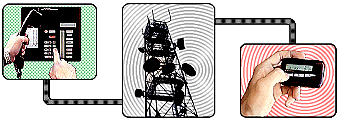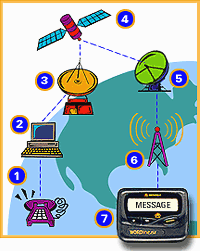Paging
may seem like magic, but it's really
very simple. Here is how it works:

Steps to Page a Numeric Pager:
1- A caller dials a pager phone number.
They're actually dialing into the paging terminal. The call reaches the
paging terminal over telephone company lines in much the same manner as
when you call a friend across town.
2- The tone a caller hears after dialing
the pager number is the paging terminal telling the caller that it is ready
to accept the page. After the message is entered, the terminal is signaled
to send the message to
the pager. The most common input devices
for sending a page are the telephone keypad (for numeric messages) and
keyboard entry devices such as a computer or connection to a dispatch service
(for text messages).
3- The paging terminal is linked to
numerous transmitters through the paging coverage area. When it receives
a message (for a specific pager), the terminal converts the message into
a pager code and relays this code to the transmitters. The transmitters
send out the code (as a radio signal) throughout the entire coverage area.
4- The code is picked up by all of
the pagers within the coverage area on that particular frequency, but only
the pager with the proper code is alerted and will display the message.

Steps to Page an Alphanumeric:
1- The page's journey begins when
someone enters a page for you, usually calling by telephone. Your page
is then converted into a digital data stream traveling over phone lines
to a public switched telephone network (PSTN) where it is rerouted onto
the paging terminal.
2- At the paging terminal, the data
stream is "back-hauled" to the
central uplink teleport.
3- Once the data stream reaches the
teleport, or earth station, it is processed by modulation equipment in
preparation for the trip to space. From the modulator, the data is sent
into space through a large satellite dish aimed at a particular paging
satellite.
4- Over 22,000 miles above the Earth,
the signal makes a U-turn at the satellite transponder. The transponder
receives the signal, amplifies it, then retransmits it back down to earth
at the speed of light.
5- Back on earth, the signal is received
by hundreds of satellite receiver dishes located near the paging transmitters.
The data stream travels from the receiver dish via cable to a digital data
receiver. From the receiver, the signal is sent to the paging transmit
controller which prepares it to be sent to your pager.
6- From the transmit controller, the
signal is broadcast via radio waves to your pager.
